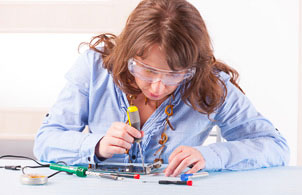|
Program Outcomes
Upon completion of the program, students will be able to:
- Identify the schematic symbols of several common electronic components and describe their functions; define terms used in electronics
- Name several electrical shock hazards, and understand how to prevent electrical shocks through lockout-and-tag procedures, proper procedures, and personal protective equipment (PPE)
- Discern the various types of conductors and their conductivity; determine the size of conductor needed for an application; identify types of insulating materials and list their temperature ratings
- Calculate voltage, resistance, and current in series, parallel, and series-parallel circuits
- Understand how to use electronics equipment, including multimeters, soldering equipment, and ohmmeters
- Read circuit diagrams, and analyze basic relay ladder diagrams
- List the various switch types, their uses, and the advantages and disadvantages of each type
- Identify many types of wires, cables, connectors, and terminals, and specify the applications for each type
- Determine the expected resistance of a wire, and estimate the change in resistance that occurs with changing wire characteristics
- Discern the differences among simple, compound, and closed magnetic circuits
- Determine the direction of magnetic lines of force around a conductor
- Calculate the total capacitance of a circuit; calculate the time constant of a resistance-capacitance (RC) or resistance-inductance (RL) circuit; calculate the total inductance of a circuit
- Explain how inductors are constructed, and describe how an inductor can regulate the flow of current in a DC circuit
- Describe how diodes and transistors work and how to determine if they're working properly; list uses for diodes and transistors in electronic systems
- Recognize the job opportunities and certifications available to electronics technicians, and name the essential job skills needed
- Explain how to test and diagnose electrical and electronic equipment using measuring and diagnostic devices, such as multimeters and oscilloscopes
- Understand and explain inductive reactance, capacitive reactance, and reactance as applied to resonant and non-resonant circuits, determine circuit Q and bandwidth
- Understand and explain pulse theory, including the generation of various waveforms, by relaxation oscillator, multivibrator, and switching circuits; describe and understand the Schmitt trigger, integrator, and differentiation circuits; explain how to troubleshoot these circuits
- Explain electronic logic circuits, including common gates and flip-flop circuits, and the use of binary numbering systems to determine circuit output
- Explain the use of NAND gates as universal devices
- Describe the various transistor/diode/resistor logic circuits and logic chip families, and the uses, applications, and troubleshooting of common logic circuits
- Explain the operating principles of linear and digital devices, including applications and considerations such as level matching, fan-in and fan-out, and selection of the appropriate device family
- Describe how to use logic devices in industrial circuits
- Understand and explain the function of memory integrated circuits
- Demonstrate knowledge of troubleshooting the various integrated circuit systems
- Perform experiments using the XK-200 Digital Trainer, which is designed for conducting hands-on experiments on linear, pulse, digital, and logic circuits
- Describe industrial computer systems and their uses, including analog and digital computer systems
- Identify the symbology for controller programs, including the symbols used to portray ladder logic, how to apply Boolean algebra principles, and how to use various computer languages to accomplish tasks from a broad overview
- Describe computer-aided design (CAD) and computer-aided manufacturing (CAM), including users, uses, and required hardware and software
- Explain the concept of interfacing hardware; describe serial interfacing, parallel interfacing, and input-output categories
- Understand analog-to-digital interfacing
- Identify applications (closing the loop), such as making measurements, controlling machines, and controlling processes
- Explain the basic interface standards, including RS232C
|
